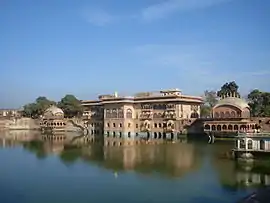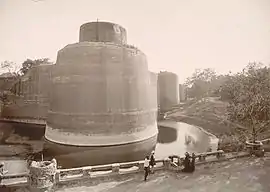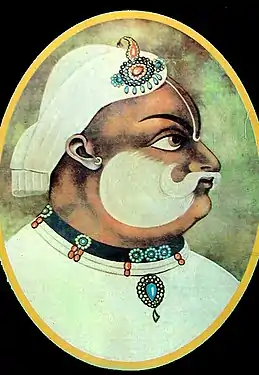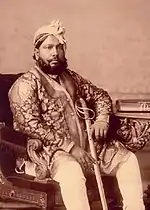Bharatpur State
Bharatpur State was a Princely state in the northern Indian subcontinent. It was ruled by the Sinsinwar clan of the Hindu Jats.
| Bharatpur State | |||||||
|---|---|---|---|---|---|---|---|
| 1680–1947 | |||||||
 Flag
 Coat of arms
| |||||||
 Bharatpur State in the Imperial Gazetteer of India | |||||||
| Area | |||||||
• 1931 | 5,123 km2 (1,978 sq mi) | ||||||
| Population | |||||||
• 1931 | 486,954 | ||||||
| History | |||||||
• Established | 1680 | ||||||
| 15 August 1947 | |||||||
| |||||||
| Today part of | Rajasthan, Republic of India | ||||||


Origin
The ancestors of the Bharatpur dynasty were Jats of Sinsinwar gotra, who followed a non-Vedic god Shin. According to a legend common to the erstwhile royal courts of Bharatpur and Karauli State, their claimed ancestor was a Yadav Rajput named Balchand. From one of his plundering raids, he brought a captured Jat and his wife to Sinsini. As Balchand's wife was infertile, he had two sons from the imprisoned Jat woman, whom he had made his concubine. His sons became Jats after being rejected as Rajputs, and, based on their village Sinsini, they made Sinsinwar as their gotra. Ram Pande notes that this legend is problematic on multiple fronts: the sons would have become Darogas after being rejected as Rajputs; caste of a child is not normally based on the mother's caste; Sinsini was never a part of Karauli. He suggests that the legend was created "to show superiority of Sinsinwar Jats over other Jats".[1][2].[3] A descendant of their leader Sua was Khanchand, whose son Bhajja became Mouza Sinsini's first zamindar. Bhajja's seven sons included Bhao Singh, Churaman, and Rajaram. Badan Singh was one of the three sons of Bhao Singh.[1]
A legend of Sinsinwar Jats states that Jats headed by Sua shifted to Usrani village of Bharatpur district as agriculturists during 13th or 14th century. But later on became zamindars after treacherously killing the Chandars, to whom they paid taxes initially. After eliminating Chandars, their Shurseni village was occupied by Jats.[4] And, based on their Sinsinwar gotra, they changed the name of Shursheni to Sinsini.[1] Historian Ram Pande notes that this legend conveys that the Jats rose to zamindar status from their initial position of peasants in this area.[4]
History
The formation of the state of Bharatpur was a result of revolts by the Jats living in the region around Delhi, Agra, and Mathura against the imperial Mughals.[5] Gokula, a local Jat zamindar of Mathura, lead the first of such revolts in 1669. Even though the Jats were defeated and Gokula was executed, the movement was not completely crushed and discontent continued to simmer.[5] In 1685, there was a second uprising of the Jats under Raja Ram Jat, that was better organized this time and used guerrilla warfare, combining it with loot and plunder.[5] Now Aurangzeb approached the Kachhwaha ruler Bishan Singh to crush the uprising and appointed him as the faujdar of Mathura, granting him the entire area in zamindari. Conflict between Jats and Rajputs for zamindari rights also complicated the issue, with Jats primarily being landowners, whereas the Rajputs were primarily revenue collectors.[5]The Jats put up a stiff resistance but by 1691, Raja Ram Jat and his successor Churaman were compelled to submit to the Imperial Mughals. However unrest among Jats continued and later on in the beginning of the 18th century, Churaman, taking advantage of the Mughal civil wars, was able to oust the Rajputs from the area and establish an independent state where Jat chiefs formed the ruling class.[5] Raja Ram Jat who also exhumed and burned the remains of Akbar is known for setting up a small fort at Sinsini. It was the key foundation of this kingdom.[6][7][8]
The most prominent ruler of Bharatpur was Maharaja Suraj Mal. He captured the important Mughal city of Agra on 12 June 1761 and it remained in the possession of Bharatpur rulers till 1774.[9] After Maharaja Suraj Mal's death, Maharaja Jawahar Singh, Maharaja Ratan Singh and Maharaja Kehri Singh (minor) under resident ship of Maharaja Nawal Singh ruled over Agra Fort.
In 1805, war between the British and the Holkars broke out. Maharaja Ranjit Singh of Bharatpur agreed to help the Holkars and the two Maharajas fell back to the Bharatpur fort. The British surrounded the fort and after three months, Ranjit Singh agreed to peace and signed a treaty with the British, thus becoming a princely state. Maharaja Jaswant Singh of Bharatpur provided great support for the British during the Indian Rebellion of 1857 and this aid was greatly acknowledged by the British. The young Maharaja was made a G.C.S.I and his personal gun salute was increased.
In August 1947, the state of Bharatpur acceded to the newly independent Dominion of India. In 1948, it became part of the Matsya Union and in 1949, it was absorbed into the state of Rajasthan. Members of the ruling family continue to be active in national and regional affairs. Several members of the family have served as members of parliament and in the state legislature.
Rulers


The chronology of the Sinsinwar rulers of Bharatpur is:
- Badan Singh, 1722–1756. 1st Raja of Bharatpur 1722/1756, of Deeg and founder of Bharatpur; he was granted the title of Brijraj by Maharaja Jai Singh II on 23 November 1722; he constructed the Royal Palace and Gardens at Deeg as well as a temple at Dhir Samir ghat of Vrindavan; he was also an accomplished poet; he married 25 Ranis, including Rani Devki of a Jat family from Kama, and had issue, 26 sons. He died 7 June 1756 at Deeg.
- Maharaja Brajendra Suraj Mal, 1756–1767. 2nd Maharaja of Bharatpur 1756/1763, born about 13 February 1707, created Raja Brajendra Bahadur, he took a large part in the numerous struggles of the first half of the 18th century between the Mughals, Marathas, Rohillas and Afghans and extended his borders until they included; married 14 wives.
- Maharaja Jawahir Singh, 1763–1768 (son of Maharaja Brajendra Surajmal Bahadur by Rani Ganga), 3rd Maharaja of Bharatpur 1763/1768,was murdered at Agra in 1768 during hunting.
- Maharaja Ratan Singh, 1768–1769 son of Maharaja Brajendra Surajmal Bahadur by Rani Ganga), 4th Maharaja of Bharatpur 1768/1771 or 1768/1769, married and had issue. He too was murdered after a short reign.
- Maharaja Keshri Singh, 1769–1771, 5th Maharaja of Bharatpur 1771 or 1769/1776, died 1776.
- Maharaja Nawal Singh, 1771–1776 (son of Maharaja Brajendra Surajmal Bahadur by Rani Kavaria), Regent of Bharatpur 1771/1776, died 1776.
- Maharaja Ranjit Singh, 1776–1805 (son of Maharaja Brajendra Surajmal Bahadur by Rani Khet Kumari), 6th Maharaja of Bharatpur 1776/1805, during his reign, Najaf Khan, stripped the Jats of all their possessions leaving only the fort of Bharatpur and territory of nine lakhs in value; after Najaf Khan's death in 1782, Maharaja Scindia seized what was left but was persuaded by Suraj Mal's widow to restore 11 districts to which a further 3 districts were later added, which afterwards remained as Bharatpur State; he provided assistance to General Lake at Agra in 1803 and was rewarded with a number of districts, however the following year, in November 1804 at the Battle of Deeg, he made open war on the British forces, repelling four assaults on his fort, until after a nearly two month siege he was compelled to make peace and a new treaty was made on 4 May 1805, by which he was made to pay an indemnity of 20 lakhs, though he was confirmed in his possessions except for the parganas made over to him in 1803; married and had issue. He died in 1805.
- Maharaja Randhir Singh, 1805–1823, 7th Maharaja of Bharatpur, died 1823. An 1805 siege by the British ended in the latter's withdrawal.
- Maharaja Baldeo Singh, 1823–1825, 8th Maharaja of Bharatpur, married and had issue. He died in 1825.
- Maharaja Durjan Sal, 1825–1826, 9th Maharaja of Bharatpur (usurper), opposed his cousin's accession and imprisoned him. British forces eventually laid siege to Bharatpur for three weeks and on 18 January 1826, the fort was stormed by troops under Lord Combermere and dismantled, the Maharaja was then imprisoned at Allahabad.
- Maharaja Balwant Singh, 1825–1853, 10th Maharaja of Bharatpur 1826/1853, born 1819, he was imprisoned by his cousin in 1825, but restored to the gadi in January 1826, under the Regency of his mother and the superintendence of the Political Agent, the Rani was removed later that same year and a Council of Regency was put in place; married and had issue. He died 1853.
- Maharaja Jashwant Singh, 1853–1893, 11th Maharaja of Bharatpur 1853/1893, born 1851, during his reign the State rendered loyal assistance to the British Government in 1857 and maintained order in the vicinity of Bharatpur; the state was administered by a Council under the Political Agent until 1872 when he was granted full ruling powers; married firstly, 1859, Maharani Bishan Kaur, daughter of Maharaja Narendra Singh of Patiala, married secondly, Maharani Darya Kaur, and had issue. He died 12 December 1893. Maharajkumar (name unknown) Singh (by Rani Bishan Kaur), died 4 December 1869. Maharaja Ram Singh (qv); Rao Raja Raghunath Singh, born 7 January 1887, educated at Mayo College, Ajmer 1895/1905 (Class-Captain 1903/1905), then with the Imperial Cadet Corps, Dehra Dun; he was appointed to the Bharatpur State Council in 1911, married and had issue. He died after 1930. Kunwar (name unknown) Singh, married and had issue. Kunwar (name unknown) Singh, married a daughter of Rai Amarjeet Singh of Kuchesar, and had issue.
- Shri Brijindar Si Maharaja Ram Singh Bahadur Jang, 1893 – 1900 (Exiled); 12th Maharaja of Bharatpur 1893/1900, born 9 September 1872 at Lohagarh, Bharatpur; installed 25 December 1893, removed from the administration of his state in 1895 and finally deposed in 1900 (#1); married firstly, Maharani Kishan Kaur, married secondly, Maharani Giriraj Kaur, died after 1918 and before 1931, and had issue, two sons and two daughters. He died 1929. Lt.Col. Shri Maharaja Shri Brajendra Sawai Kishen Singh Bahadur Jang (by Maharani Giriraj Kaur)(qv) Maharaj Giriraj Singh; Maharajkumari Gajindar Kaur; Maharajkumari Gokul Kaur
- Maharani Giriraj Kaur, regent 1900–1918.
- Lt.Col. Shri Maharaja Shri Brajendra Maharaja Kishen Singh Bahadur Jang, 1900–1929, 13th Maharaja of Bharatpur 1900/1929, born 4 October 1899, K.C.S.I. [cr.1926]; educated at Mayo College, Ajmer (College Diploma 1916) and for a short time at Wellington College, England in 1914; he was granted full ruling powers in November 1918, he was responsible for a number of reforms in the state of Bharatpur, including a reorganization of the army in 1919, Hindi was made the state language, primary education was made compulsory, Ayurvedic hospitals were set up, an exhibition to promote trade and arts was set up on an annual basis, the introduction of a system of participation of public in state affairs through credit banks, issuing society and village panchayat acts was started, the Brij-mandal in Shimla was established, and Social Reform Acts were enacted; he was appointed an Honorary Lieutenant-Colonel in the British Army on 24 October 1921, he presided over the Jat Mahasabha Adhiveshan organized at Pushkar in 1925; in consequence of the disorganisation of the State Administration and Finances he was deprived of his ruling powers in September 1928; married 3 March 1913, a daughter of Kunwar Gajindar Singh of Faridkot, died 18 August 1929, and had issue, four sons and three daughters. He died 27 March 1929 (#2). Shri Maharaja Shri Brajendra Sawai Vrijendra Singh Bahadur Jang (qv); Rao Raja Gajendra Singh [Girendra Raj Singh], died 1940. Rao Raja Edward Man Singh, born in July 1920 (1922?), married Rani Anant Mala, Princess of Kagal Junior, born 1926, died 1991, and had issue, three daughters. He died in February 1985. (Rajkumari Girrendra Kaur, born 5 November 1946, married 23 May 1972, Brig. Jitendra Pal Singh of Saidpur, and has issue, one son and one daughter. Kumari Gauri Singh; Kanwar Gaurav Singh; Rajkumari Ravindra Kaur, born 4 June 1952, unmarried. Rajkumari Krishnendra Kaur, born 10 April 1954, married 26 April 1982, Kanwar Vijay Singhji of Sihi, and has issue, one son and one daughter. Kumari Ambika Singh; Kanwar Dushyant Singh; Rao Raja Giriraj Saran Singh, born in September 1924?, M.P.(Lok Sabha) from Mathura, serving two terms, married firstly, January 1942 (div.1958), Maharajkumari Sushila Devi of Kapurthala, born 14 December 1918 at Kapurthala, died 1974 in Simla, married secondly, 1962, Mrs. Pamela Singh (divorced from her first husband), and had issue. He died December 1969. Rajkumar Anup Singh, born 25 December 1942, educated at Bishop Cotton School, Simla and Cornell University in the US, studying a course in agricultural management, married firstly, 1969 (div. 1974), Kumari Vijaya Kumari, born 1951, daughter of Thakur Gopal Singh of Bhajji State, a forest range officer better known as Mooshoo Mian, married secondly, May 1980, Surrinder Kaur, born 1946, a Sikh lady from Shahzadpur jagir in Haryana, no issue. Rajkumar Arun Singh [Prince Oogie], born 13 February 1947, educated at Bishop Cotton School, Simla and at St. Stephen's College, Delhi University; M.L.A. (three times) from Deeg constituency in Bharatpur District, first elected M.L.A.in 1993 as an independent. He was twice an independent M.L.A. and the third time he stood and won from the I.N.L.D. party ticket. He died unmarried 15 March 2006 at the All India Institute of Medical Sciences Hospital of kidney failure. His body was taken to Bharatpur on the same day, and he was given a state funeral (as he was an M.L.A.) at the Bharatpur Royal Cemetery. Maharajkumari Bibiji Kusum Kaur, married 1933, Kanwar Surendra Pal Singh of Unchagaon, Bulandshar District in the United Provinces. Maharajkumari Bibiji (name unknown) Kaur, died 19 May 1930 at Mussoorie. Maharajkumari Bibiji Padma Kaur (Kunwarani Vrish Bhan Kunwar), born 18 September 1919, married Kunwar Brijendra Singh of Moradabad District., and had issue. She died 1945 in Mysore.
- Colonel Shri Maharaja Brajendra Sawai Vrijendra Singh Bahadur Jang, 1929–1947 (Signed the instrument of accession to the Indian Union), 14th Maharaja of Bharatpur 1929/1995, born 1 December 1918; he succeeded to the gadi on 14 April 1929; Member of the Lok Sabha 1962/1971; married firstly June 1941, Yuvarajkumari Jaya Chamunda Ammani Avaru [the Maharani of Bharatpur], died 1954, daughter of Yuvaraja Sir Sri Kantirava Narasinharaja Wadiyar of Mysore, and his wife, Yuvrani Kempu Cheluvammanniyavaru, married secondly, 1961 (div. 1972), Maharani Videh Kaur of the Urs family of Mysore, born 1933, died 1985, by whom he had issue. He died 8 July 1995.
The line is nominally continued
- Shri Maharaja Shri Brajendra Sawai Vishvendra Singh Bahadur Jang, 15th Maharaja of Bharatpur.[10]
Symbols

The former flag of the princely state was a rectangular tricolor with three horizontal stripes of saffron, white and blue. Its design and colour scheme happened to be very similar to the official flag that would be adopted for the future independent Dominion of India.
In the last three years before joining the Indian Union a new flag was adopted for Bharatpur that had a broad Chartreuse coloured band and the coat of arms in the middle.[11] During that brief period (c.1943 – 1947) Bharatpur became the only political entity ever to have a chartreuse coloured flag. Bharatpur State also had an elaborate coat of arms.
See also
Notes
- Pande, Ram (1970). Bharatpur up to 1826: A Social and Political History of the Jats (1st ed.). Rama Publishing House. p. 29. OCLC 610185303.
- "tonk3". www.royalark.net. Retrieved 9 February 2021.
- Social and Political History of the Jats, Bharatpur Upto 1826 3.Shodhak. pp. 28–29.
- Pande, Ram (1970). Bharatpur up to 1826: A Social and Political History of the Jats (1st ed.). Rama Publishing House. p. 28. OCLC 610185303.
- Chandra, Satish (1990). Medieval India. India: National Council for Educational Research and Training. pp. Chapter 18 p. 295, 296.
- Chiefs and Leading Families in Rajputana, Office of the Superintendent of Government Printing, Calcutta, 1894, 1903 and 1916.
- Kunj Bihari Lal Gupta. The Evolution of the Administration of the former Bharatpur State. Vidya Bhawan Publishers, Jaipur, 1959.
- Tony McClenaghan. Indian Princely Medals: A record of the Orders, Decorations and Medals of the Indian Princely States. Lancer Publications, Spantech & Lancer, New Delhi, 1996.
- Prakash Chandra Chandawat: Maharaja Suraj Mal aur unka yug, Jaypal Agencies Agra, 1982, Pages 197–200
- "Genealogy of Bharatpur". Archived from the original on 1 April 2009.
- Flags of Bharatpur – Roberto Veschi
References
- Imperial Gazetteer of India Vol 8, P-73 Bharatpur State
- R. C. Majumdar, H.C. Raychaudhury, Kalikaranjan Datta: An Advanced History of India, fourth edition, 1978, ISBN 0-333-90298-X, p. 535-36
- Attribution
![]() This article incorporates text from a publication now in the public domain: Chisholm, Hugh, ed. (1911). "Bharatpur". Encyclopædia Britannica (11th ed.). Cambridge University Press.
This article incorporates text from a publication now in the public domain: Chisholm, Hugh, ed. (1911). "Bharatpur". Encyclopædia Britannica (11th ed.). Cambridge University Press.
External links
 Media related to Bharatpur State at Wikimedia Commons
Media related to Bharatpur State at Wikimedia Commons